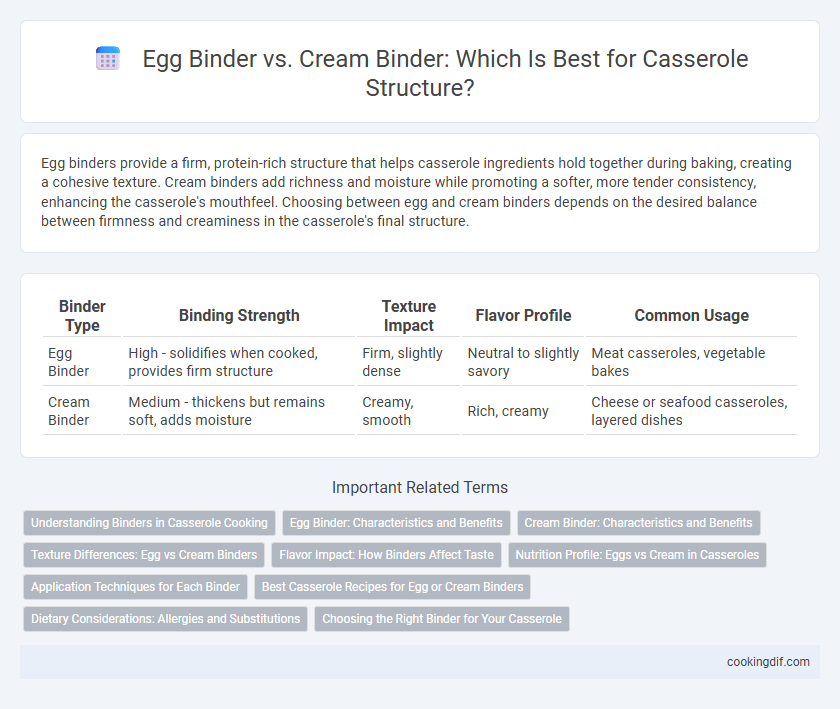Egg binders provide a firm, protein-rich structure that helps casserole ingredients hold together during baking, creating a cohesive texture. Cream binders add richness and moisture while promoting a softer, more tender consistency, enhancing the casserole's mouthfeel. Choosing between egg and cream binders depends on the desired balance between firmness and creaminess in the casserole's final structure.
Table of Comparison
| Binder Type | Binding Strength | Texture Impact | Flavor Profile | Common Usage |
|---|---|---|---|---|
| Egg Binder | High - solidifies when cooked, provides firm structure | Firm, slightly dense | Neutral to slightly savory | Meat casseroles, vegetable bakes |
| Cream Binder | Medium - thickens but remains soft, adds moisture | Creamy, smooth | Rich, creamy | Cheese or seafood casseroles, layered dishes |
Understanding Binders in Casserole Cooking
Egg binders provide a firm and cohesive texture by coagulating proteins during baking, ensuring the casserole holds its shape well. Cream binders contribute richness and moisture, creating a smooth, tender structure without making the dish overly dense. Choosing between egg and cream binders depends on the desired texture and flavor intensity in casserole recipes.
Egg Binder: Characteristics and Benefits
Egg binders provide a strong, natural structure in casseroles by coagulating during baking, which helps hold ingredients together firmly. They add protein and contribute to a richer texture while enhancing the overall nutritional value of the dish. Their versatility allows them to blend seamlessly with various ingredients without overpowering flavors, resulting in a cohesive and satisfying casserole.
Cream Binder: Characteristics and Benefits
Cream binder in casseroles enhances texture by providing a rich, smooth consistency that holds ingredients together effectively. Its high fat content adds moisture and richness, resulting in a creamy mouthfeel and improved flavor absorption. Unlike egg binders, cream offers less rigidity, contributing to a tender, cohesive structure that prevents dryness and enhances the overall dish quality.
Texture Differences: Egg vs Cream Binders
Egg binders provide a firm, cohesive texture in casseroles, creating a structured and slightly dense bite essential for holding ingredients together. Cream binders contribute a rich, smooth, and velvety mouthfeel, resulting in a softer, more tender casserole consistency. The choice between egg and cream binders directly influences the casserole's final texture, balancing between sturdiness and creaminess.
Flavor Impact: How Binders Affect Taste
Egg binders in casseroles create a rich, savory flavor that enhances the overall taste while providing a firm, cohesive structure. Cream binders contribute a smooth, velvety texture and a subtle dairy sweetness, enriching the casserole with a creamy depth. Choosing between egg and cream binders significantly influences both the flavor profile and the casserole's mouthfeel, with eggs offering a more pronounced, hearty taste and cream delivering a mild, luscious finish.
Nutrition Profile: Eggs vs Cream in Casseroles
Eggs in casseroles provide high-quality protein, essential amino acids, and vital nutrients like vitamin D and choline, contributing to muscle repair and brain health. Cream adds rich fat content, primarily saturated fats, along with fat-soluble vitamins A and E, enhancing calorie density and texture but increasing cholesterol levels. Choosing eggs over cream as a binder offers a leaner nutritional profile with more protein and fewer calories, suitable for health-conscious diets.
Application Techniques for Each Binder
Egg binders provide a firm, cohesive structure in casseroles, making them ideal for recipes requiring a stable, sliceable texture; they are best applied by thoroughly beating and evenly mixing eggs into the casserole ingredients before baking. Cream binders contribute a rich, creamy consistency and slight moisture retention, suitable for softer, creamier dishes, and are typically folded gently into the mixture to maintain tenderness. Understanding the binder's properties ensures proper technique selection, resulting in optimal casserole texture and structural integrity.
Best Casserole Recipes for Egg or Cream Binders
Egg binders provide a firm, cohesive structure in casseroles, making them ideal for recipes like quiche or strata where a solid texture is desired. Cream binders contribute a rich, creamy consistency, perfect for dishes such as scalloped potatoes or creamy vegetable bakes that benefit from moisture and smoothness. Selecting the best binder depends on the desired texture and flavor profile, with eggs offering stability and cream enhancing indulgence in casserole recipes.
Dietary Considerations: Allergies and Substitutions
Egg binders provide strong structural support in casseroles but may trigger allergies in individuals sensitive to eggs, necessitating alternatives. Cream binders, often made from dairy products like heavy cream or sour cream, offer a rich texture but pose lactose intolerance concerns for some people. Substitutions such as plant-based creams or egg replacers made from flaxseed or aquafaba can maintain casserole structure while accommodating dietary restrictions.
Choosing the Right Binder for Your Casserole
Egg binders provide superior structure and cohesiveness for casseroles, offering a firm texture that holds ingredients together during baking. Cream binders, such as heavy cream or sour cream, deliver a rich, moist consistency that enhances flavor while adding a softer, creamier texture. Selecting between egg and cream binders depends on the desired firmness and moisture level, with eggs best for solid form and creams ideal for a tender, luscious finish.
Egg Binder vs Cream Binder for casserole structure Infographic

 cookingdif.com
cookingdif.com